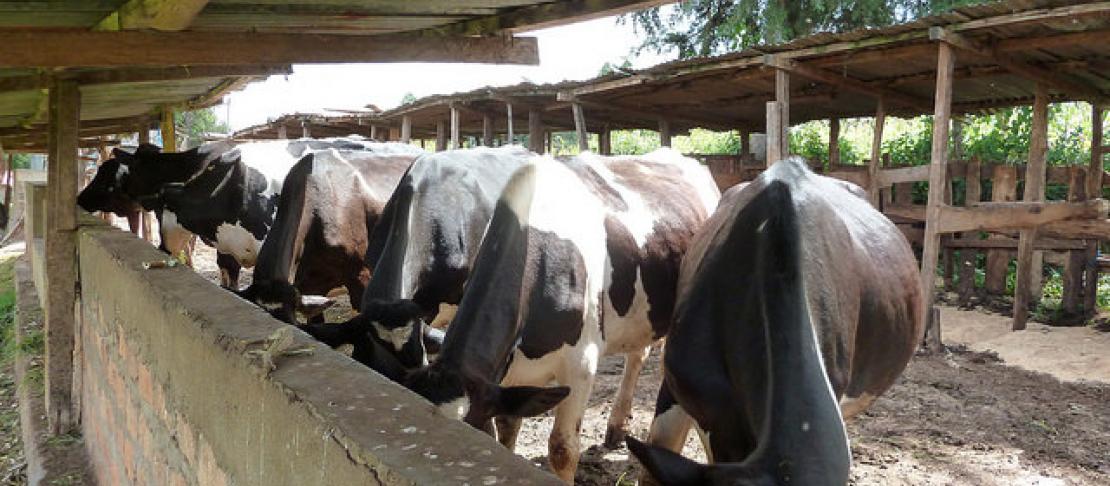Kenya develops and implements a Nationally Appropriate Mitigation Action (NAMA) in the dairy sector

Project description
In Kenya, sustainable intensification of dairy farming is likely to increase incomes and improve nutritional outcomes for rural smallholder livestock producers. Realizing this potential, Kenya has developed national development strategies supportive of productivity-enhancing and climate resilient investments. National strategies include Vision 2030, the National Climate Change Action Plan, the National Dairy Master Plan and the Climate-Smart Agriculture Framework Policy. The private sector also sees opportunity: Kenya’s dynamic agribusiness sector provides a conducive environment for locally owned climate-smart agriculture initiatives. However, growth in Kenya’s dairy sector historically has been limited by inefficient resource use, low productivity, and high sensitivity to climate change impacts because they depend on rain-fed production systems. Together, these factors result in livestock producers with limited resilience to market or climate fluctuations and high greenhouse gas emissions per kilogram of milk (called emission intensity).
This project aimed to build on the significant potential to increase productivity and climate resilience while reducing emissions in the dairy sector by working with the government of Kenya to develop a Nationally Appropriate Mitigation Action (NAMA) for the dairy sector. This research project supported private and public stakeholders at local and national levels to develop, pilot, and scale up activities that promote dairy development. In particular, this research supports activities that deliver higher productivity while reducing emissions. The project also contributed to the development of an institutional framework and financing mechanisms, identifies best practices at farm level and in extension services, and deploys the best available science to develop monitoring, reporting and verification (MRV) approaches that are accurate, reliable, feasible and comply with international climate agreements and climate finance requirements.
The project analyzed on-farm practices and climate-smart business models, including how the practices and business models may contribute to increased gender equity. Project results were analyzed to see how recommendations for promoting dairy development impact on women. The project aimed to have roughly equal numbers of men and women participate in the process of developing institutional arrangements for the NAMA in order to increase the likelihood that the issues and needs of diverse groups are addressed, and that all socio-economic groups are actively involved in implementation. The project also attempted to include women and men in different age and social groupings and collects sex-disaggregated data whenever possible.
This project supported the development and implementation of the Kenyan NAMA to scale up and reach more than 600,000 dairy farmers and reduce greenhouse gas emission intensities in the dairy sector by at least 30%.
Even in its development phase, Kenya’s dairy NAMA spurred action in the East African region through established networks and collaboration among livestock sector stakeholders, especially in Tanzania and Uganda.
Publications
- 2016. Best practice guide to socially and gender-inclusive development in the Kenyan intensive dairy sector. ILRI Project Report. Nairobi, Kenya: ILRI.
- 2016. Gender dynamics in dairy production in Kenya: A literature review. CCAFS Working Paper no. 182.2016. Low-emission and climate resilient dairy development in Kenya. Concept note for the Green Climate Fund.
- 2016. Dairy partners in Kenya meet to discuss increased productivity, reduced emissions. CCAFS blog.
- 2015. Climate-smart livestock sector development: the state of play in NAMA development. CCAFS Working Paper No. 105.2015. Reducing emissions from Kenya's dairy sector. CCAFS blog.
- 2015. Scaling up climate-smart dairy practices in Kenya through Nationally Appropriate Mitigation Actions. CCAFS Outcome Case.
- 2015. Steps towards Nationally Appropriate Mitigation Actions for Kenya’s dairy sector. ICRAF blog.
- 2015. SB42 Side Event: Livestock-related NAMAs in Costa Rica, Kenya and Mongolia
Outputs
Research activities and results from the Kenya NAMA Project are now informing the "Enhancing capacities for MRV of sustainable livestock actions in East Africa" project beginning in 2019. The project supported a refined NAMA proposal for engagement with investors, including a precise MRV framework, and a Kenya Dairy NAMA MRV system and guidelines for users. Specific works in progress are:
- 2017. Technology adoption in Kenya's dairy sector: A review of factors influencing the adoption of technologies and management practices by smallholder dairy producers in Kenya.
- 2017. Access to and supply of finance for enhancing dairy productivity. CCAFS Working Paper.
- 2017. Suitability of project M&E systems to support agricultural MRV: The case of the dairy NAMA. CCAFS Working Paper.
- 2017. The potential for commercial hay production in Kenya. CCAFS Info Note.
- 2017. Private-sector led extension in Kenya’s dairy sector. CCAFS Info Note.
- 2017. The potential for reduced consumption of high-emission energy in Kenya’s dairy sector. CCAFS Info Note.
Partners
The World Agroforestry Centre (ICRAF) led this project in partnership with UNIQUE forestry and land use and in close collaboration with UN FAO, IFAD and ILRI. Kenyan partners include the State Department of Livestock at the Ministry of Agriculture, Livestock and Fisheries (MoALF), the Ministry of Environment and Natural Resources (MENR) and the Kenya Dairy Board. Throughout the NAMA development process numerous other stakeholders have been involved, including dairy processors, dairy sector association representatives, commercial hay growers, financial institutions, biogas companies, development organizations and national and international research organizations.
More information
For further information, please contact Project Leader Todd Rosenstock (ICRAF) at t.rosenstock@cgiar.org and Suzanne van Dijk (UNIQUE) at Suzanne.vanDijk@unique-landuse.de.